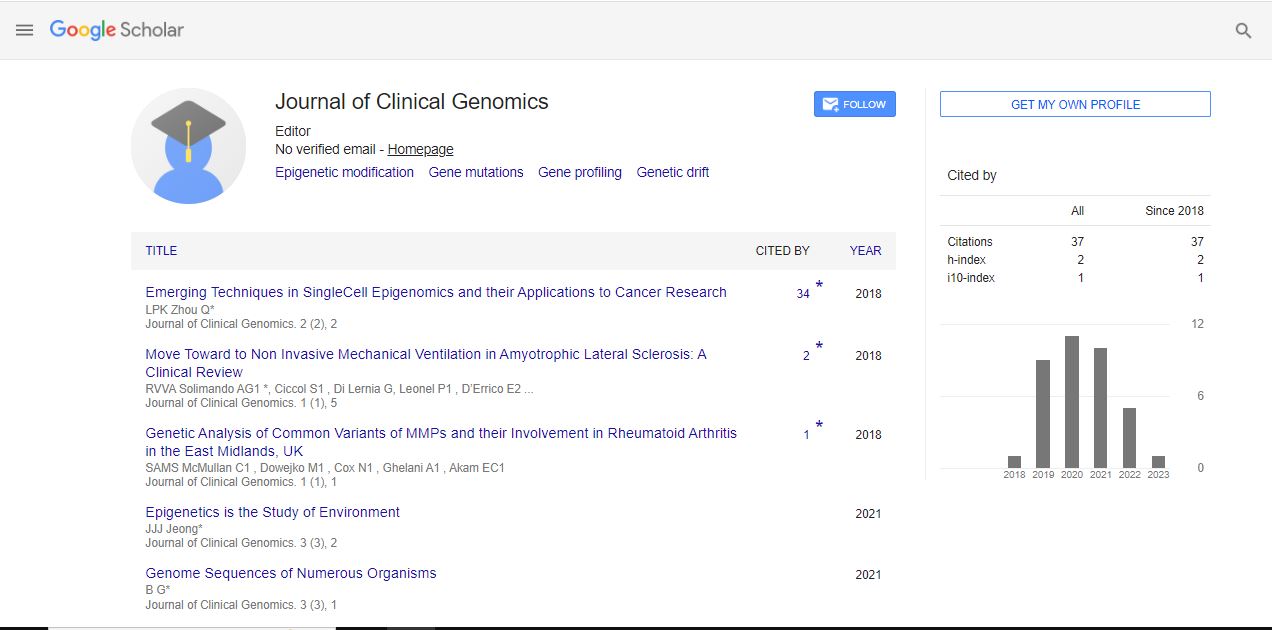Commentary, J Chromatography Res Vol: 6 Issue: 4
Authentication and Quality Control of Food Products Using Chromatography Techniques
Kathleen Choe*
1 Department of Chemical and Biomolecular Engineering, University of Delaware, Newark, USA
*Corresponding Author: Kathleen Choe,
Department of Chemical and
Biomolecular Engineering, University of Delaware, Newark, USA
E-mail: Chloek_21435@gmail.com
Received date: 27 November, 2023, Manuscript No. JCGR-24-123807;
Editor assigned date: 29 November, 2023, Pre QC No. JCGR-24-123807 (PQ);
Reviewed date: 14 December, 2023, QC No. JCGR-24-123807;
Revised date: 21 December, 2023, Manuscript No. JCGR-24-123807 (R);
Published date: 28 December, 2023, DOI: 10.36648/JCGR.1000074.
Citation: Choe K (2023) Authentication and Quality Control of Food Products Using Chromatography Techniques. J Chromatography Res 6:4.
Description
Ensuring the authenticity and quality of food products is a critical aspect of modern food safety and regulatory practices. With the increasing complexity of global food supply chains, the need for reliable analytical techniques to authenticate and control the quality of food products has grown substantially. Chromatography, a versatile and powerful analytical method, plays a pivotal role in these efforts. This essay explores the application of chromatography techniques in the authentication and quality control of food products, emphasizing the importance of accurate and reliable analysis in ensuring consumer safety and regulatory compliance.
The food industry faces challenges related to adulteration, mislabeling, and contamination, all of which can compromise the safety and quality of food products. Authentication, the process of confirming the origin, identity, and composition of food products, is crucial for preventing fraud and ensuring that consumers receive what is stated on the label. Quality control involves systematic measures to guarantee that food products meet the specified standards and regulations, encompassing factors such as freshness, purity, and nutritional content.
Chromatography techniques are widely employed in the analysis of food products due to their ability to separate, identify, and quantify complex mixtures of compounds. The versatility of chromatography allows for the analysis of a broad range of analytes, including volatile and non-volatile compounds, making it well-suited for addressing the diverse challenges in food authentication and quality control.
Gas Chromatography (GC)is extensively used for the analysis of volatile compounds in food products. Key applications include the detection of flavors, aromas, and contaminants such as pesticides and mycotoxins. GC separates volatile compounds based on their affinity for the stationary phase within a capillary column, and the elution order and time provide valuable information about the composition of the sample.
Liquid Chromatography (LC) is a versatile technique employed in the analysis of non-volatile compounds, including sugars, organic acids, and various contaminants. High-Performance Liquid Chromatography (HPLC) and Ultra-High-Performance Liquid Chromatography (UHPLC) are commonly used for their efficiency and speed. HPLC, for example, can be utilized for the analysis of food additives, preservatives, and vitamins.
Thin-Layer Chromatography is a cost-effective method used for preliminary screening of food samples. It is particularly valuable for detecting the presence of specific compounds such as colorants, lipids, and certain contaminants. TLC is quick and simple, making it a useful tool for routine checks in food quality control. Gas Chromatography- Mass Spectrometry (GC-MS) and Liquid Chromatography-Mass Spectrometry (LC-MS) is coupling chromatography with mass spectrometry enhances the specificity and sensitivity of the analysis. GC-MS and LC-MS are powerful tools for the identification and quantification of compounds in complex food matrices. These techniques are essential for the analysis of food contaminants, adulterants, and the verification of product authenticity.
Chromatography techniques are employed to determine the geographical origin of food products, which is crucial for products with designated geographical indications. Isotope ratio analysis using techniques like Gas Chromatography-Isotope Ratio Mass Spectrometry (GC-IRMS) or Liquid Chromatography-Isotope Ratio Mass Spectrometry (LC-IRMS) can trace the isotopic composition of certain elements, providing valuable information about the origin of products like olive oil, wine, and honey. Food fraud involving the mislabeling of species is a significant concern. Chromatography, often coupled with mass spectrometry, is used to authenticate the species origin of meat, fish, and other animal products. DNA-based methods coupled with chromatography, such as Polymerase Chain Reaction (PCR) coupled with Liquid Chromatography (PCR-LC), can identify the presence of specific DNA markers to confirm the species identity.
Adulteration, the intentional addition of inferior or undeclared substances, is a common issue in the food industry. Chromatography plays a pivotal role in detecting adulterants such as unauthorized additives, diluents, or contaminants. For example, Gas Chromatography coupled with Flame Ionization Detection (GC-FID) can identify the presence of synthetic substances in natural products like essential oils.
Chromatography is widely used for the analysis of pesticide residues in fruits, vegetables, and grains. Gas Chromatography with Electron Capture Detection (GC-ECD) or Mass Spectrometric detection (GC-MS) and Liquid Chromatography with tandem Mass Spectrometry (LC-MS/MS) are common techniques for determining pesticide levels in food products, ensuring compliance with regulatory limits. Mycotoxins, produced by fungi, pose a significant threat to food safety. Chromatography techniques are employed for the detection and quantification of mycotoxins in commodities such as grains, nuts, and dried fruits. High-performance liquid chromatography with fluorescence detection (HPLC-FLD) and LCMS/ MS are commonly used for mycotoxin analysis.
 Spanish
Spanish  Chinese
Chinese  Russian
Russian  German
German  French
French  Japanese
Japanese  Portuguese
Portuguese  Hindi
Hindi 